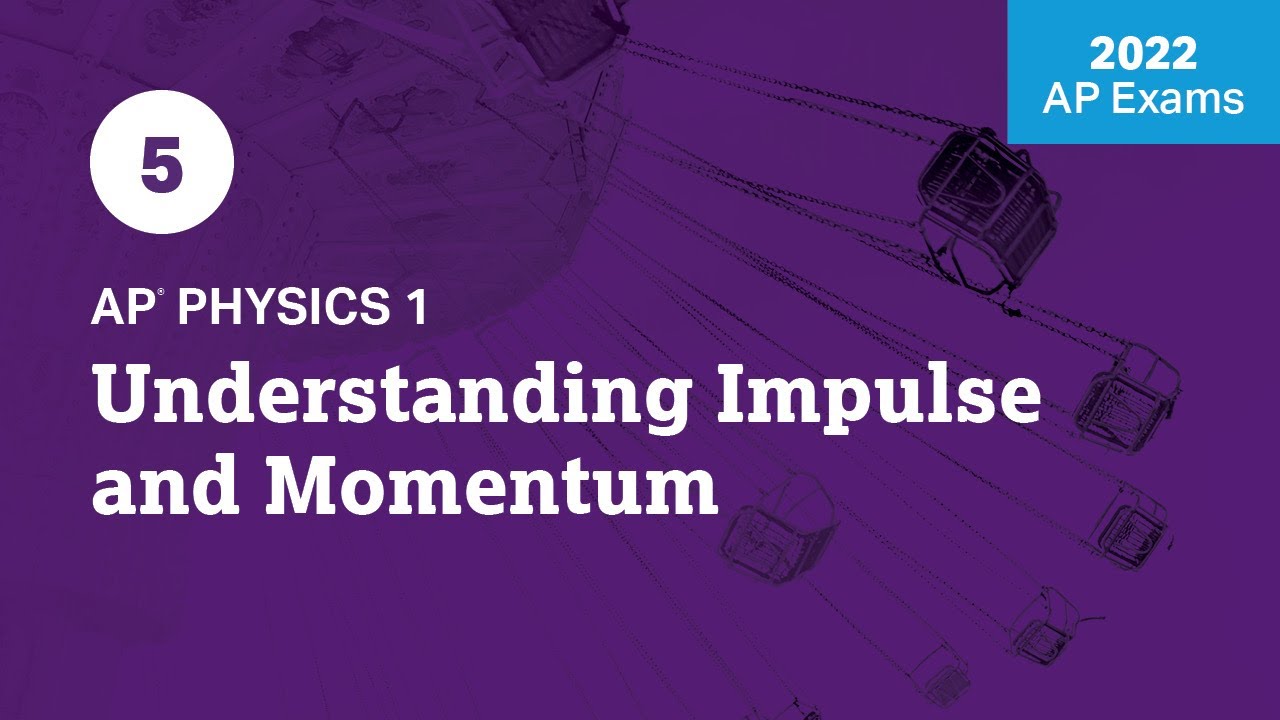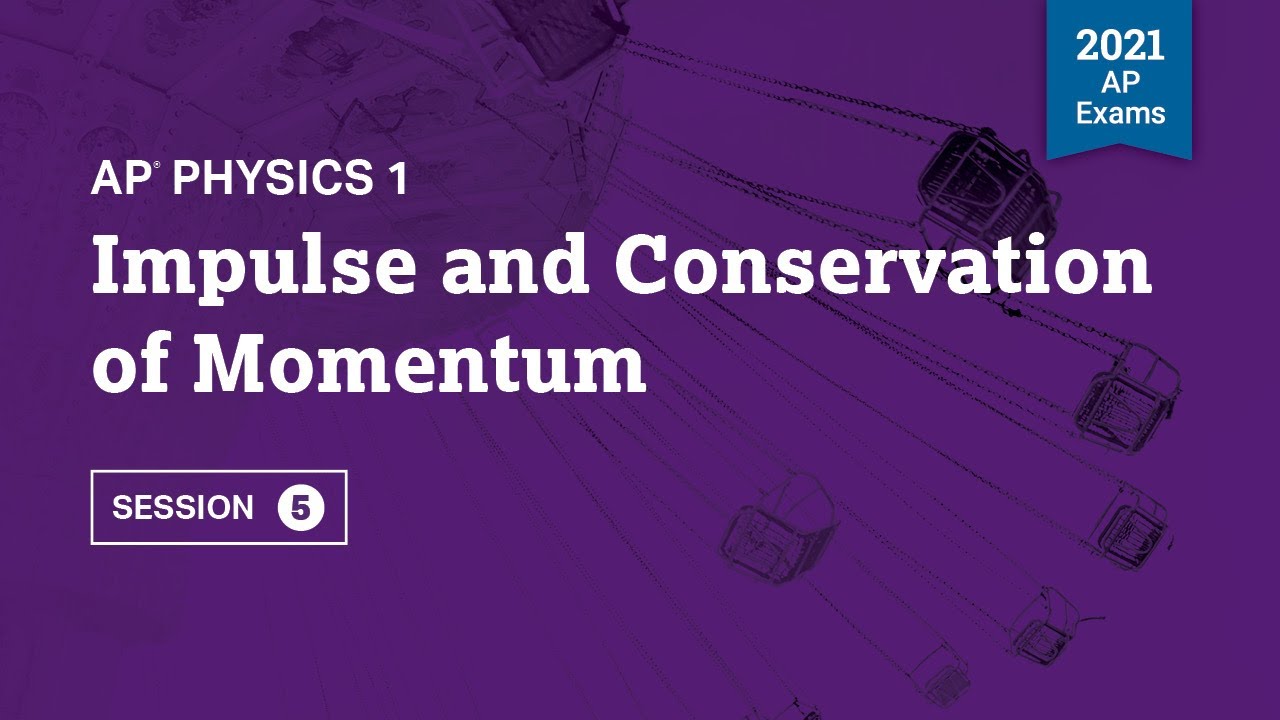College Physics 1: Lecture 27 - Conservation of Momentum
TLDRIn this physics lecture, the concept of momentum conservation is introduced as a fundamental law in physics, applicable to isolated systems without external forces. The lecturer explains the relationship between force, impulse, and momentum, using Newton's third law as a foundation. Through three examples, the application of conservation of momentum is demonstrated, including problems involving collisions, catching a ball on a skateboard, and a two-dimensional explosion scenario. The lecture also discusses perfectly inelastic collisions and explosions, highlighting the vector nature of momentum and the complexities involved in multi-dimensional problems. Practical applications and thought experiments, such as choosing between a clay ball and a Super Ball to close a door during a fire, are used to illustrate the principles discussed.
Takeaways
- 💡 Conservation of momentum is the first conservation law introduced in the course.
- 📘 Newton's third law states that for every action, there is an equal and opposite reaction.
- ↔️ Equal and opposite forces during a collision result in equal and opposite impulses.
- ⚖️ The law of conservation of momentum states that the total momentum of an isolated system remains constant.
- 🧩 Momentum conservation can be applied to solve problems involving collisions and explosions.
- 🚀 In perfectly inelastic collisions, objects stick together and move with a common velocity.
- 🎯 Conservation of momentum equations can expand quickly, requiring careful tracking of subscripts and components.
- 🔢 Problems often simplify by identifying zero initial velocities or directions without components.
- 📐 Two-dimensional problems require separate conservation of momentum equations for each direction.
- 🔄 During collisions, changes in momentum of colliding objects are equal and opposite, ensuring total momentum is conserved.
Q & A
What is the significance of conservation laws in physics?
-Conservation laws in physics represent the highest level of discussion or detail, indicating fundamental principles that are extremely important for understanding physical phenomena.
What is the relationship between impulse and momentum?
-Impulse is defined as the average force multiplied by the time it acts (J = F * Δt), and according to the impulse-momentum theorem, the impulse delivered to an object will change its momentum (J = ΔP).
How does Newton's third law relate to the conservation of momentum?
-Newton's third law states that for every action, there is an equal and opposite reaction. This means that the forces exerted by interacting objects are equal and opposite, leading to equal and opposite impulses, and consequently, the conservation of momentum in an isolated system.
What is the conservation of momentum principle?
-The law of conservation of momentum states that the total momentum of an isolated system remains constant if no external forces are acting upon it, meaning the initial total momentum equals the final total momentum (P_initial = P_final).
What does it mean for a collision to be perfectly inelastic?
-A perfectly inelastic collision is one in which the two objects involved in the collision stick together and move with a single common velocity after the collision.
How can the conservation of momentum be applied to solve problems involving collisions?
-The conservation of momentum can be used to set up equations where the total momentum before a collision equals the total momentum after the collision. This allows for the calculation of unknown velocities or masses involved in the collision.
What is the difference between a one-dimensional and a two-dimensional conservation of momentum problem?
-A one-dimensional problem involves motion along a single axis (either horizontal or vertical), while a two-dimensional problem involves motion in both the horizontal and vertical axes, requiring separate equations for each direction.
Why is it important to consider the direction of velocities when applying the conservation of momentum?
-Direction is crucial because momentum is a vector quantity, meaning both magnitude and direction are important. Velocities in different directions must be considered separately, and the conservation of momentum equation must account for these vector components.
In the context of the lecture, why would a super bouncy ball be more effective than a sticky ball of clay for closing a door during a fire?
-The super bouncy ball would be more effective because it would result in a larger change in momentum due to its bouncing off the door, which according to the impulse-momentum theorem, results in a larger impulse and therefore a greater force being applied to close the door.
What is the trick behind the question of which object, a mosquito or a truck, experiences a larger change in momentum during a head-on collision?
-The trick is in understanding that the change in momentum is the same for both objects due to the conservation of momentum. Even though the truck is much more massive, the mosquito gains the same amount of momentum that the truck loses, making their changes in momentum equal.
Outlines
🚀 Introduction to Conservation of Momentum
This paragraph introduces the concept of conservation of momentum in physics, emphasizing its importance as a fundamental law. It explains that momentum, defined as mass times velocity, is conserved during interactions, such as collisions, where the total momentum before and after the event remains unchanged. The lecturer sets the stage for a deeper dive into this principle by stating that it will be explored through a series of examples to solidify the understanding of this crucial concept.
📚 Detailed Explanation of Conservation of Momentum
The lecturer elaborates on the conservation of momentum, starting with Newton's third law, which states that forces between interacting objects are equal and opposite. This leads to the concept that impulses (force over time) are also equal and opposite, resulting in changes in momentum that are equal in magnitude but opposite in direction. The total momentum of an isolated system remains constant, whether in one or multiple dimensions, and the equation for conservation of momentum is introduced, highlighting its complexity and applications in various scenarios.
🧩 Solving Problems Using Conservation of Momentum
The paragraph demonstrates how to apply the conservation of momentum to solve problems, starting with a simple example involving two people pushing off each other on frictionless ice. The equation is expanded to include mass and velocity, and simplified by recognizing initial velocities are zero. This leads to a formula to calculate the final velocity of one of the individuals, showcasing the practical application of the conservation law in a real-world scenario.
🎯 Catching a Ball on a Skateboard: An Inelastic Collision
This section presents a problem involving Jack, who stands on a skateboard and catches a ball thrown at him. The scenario is described as a perfectly inelastic collision, where Jack and the ball combine into a single object with a common velocity after the collision. The conservation of momentum principle is used to find Jack's final speed after catching the ball, taking into account the mass and initial velocity of the ball and the combined mass of Jack and the skateboard.
🌐 Two-Dimensional Explosion Problem
The paragraph introduces a complex two-dimensional problem involving an explosion that sends three pieces of a coconut in different directions. The initial setup is described, with all pieces initially at rest and the explosion causing them to move with specific velocities. The problem requires the use of both X and Y components to find the speed and direction of the third piece, which has twice the mass of the other two pieces.
📉 Solving for the Velocity Components of the Third Piece
The lecturer guides through the process of solving for the velocity components of the third piece of the coconut in the X and Y directions. Using the conservation of momentum, the equations for both directions are set up and simplified by recognizing that some initial velocities are zero. The solution involves algebraic manipulation and understanding the relationship between the masses of the pieces, ultimately finding the X and Y components of the third piece's velocity.
📐 Direction and Magnitude of the Third Piece's Velocity
The paragraph concludes the problem by combining the X and Y components of the third piece's velocity to find its overall speed and direction. Using the Pythagorean theorem, the magnitude of the velocity is calculated, and the direction is found using the inverse tangent function. The final answer is presented, showing the piece will move at a speed of 14 meters per second at a 45-degree angle above the horizontal.
🛑 End of Lecture Questions on Momentum
The lecture concludes with two thought-provoking questions related to momentum. The first question involves a scenario where one must choose between a sticky ball of clay and a super bouncy ball to close a door in a fire emergency, highlighting the importance of understanding momentum change and impulse. The second question addresses a head-on collision between a mosquito and a truck, illustrating the principle that the change in momentum is the same for both objects, despite their vastly different masses and the intuitive misconception that might arise from it.
Mindmap
Keywords
💡Conservation of Momentum
💡Impulse
💡Newton's Third Law
💡Inelastic Collision
💡Explosions
💡Frictionless Ice
💡Vector Quantities
💡Momentum
💡Isolated Systems
💡Impulse-Momentum Theorem
Highlights
Introduction of the law of conservation of momentum, a fundamental principle in physics.
Momentum defined as mass times velocity, setting the stage for the conservation law.
Explanation of impulse and its relation to force and time during collisions.
Newton's third law and its implication on the equality and oppositeness of forces during interactions.
The concept that equal and opposite forces result in equal and opposite impulses.
How impulses relate to changes in momentum, leading to the conservation of momentum.
The total momentum of an isolated system remains constant, regardless of internal interactions.
The equation p_initial = p_final encapsulates the conservation of momentum.
Complexity arises with multiple objects and vector components in the conservation law.
Introduction of the perfectly inelastic collision, where objects stick together post-collision.
Explosions as the opposite of collisions, with objects moving apart in different directions.
Solving a one-dimensional collision problem involving two people pushing off each other.
The significance of initial conditions and how they simplify the conservation of momentum equation.
A problem involving a skateboarder catching a ball and the resulting change in momentum.
The solution to a two-dimensional explosion problem, calculating the velocity of a third piece.
The use of Pythagorean theorem to find the magnitude of velocity in a two-dimensional problem.
Practical application of conservation of momentum in emergency situations, like a fire escape.
The paradoxical nature of momentum change in a mosquito and truck collision, both experiencing equal changes.
Transcripts
Browse More Related Video

2022 Live Review 5 | AP Physics 1 | Understanding Impulse and Momentum

High School Physics - Conservation of Momentum

2021 Live Review 5 | AP Physics 1 | Impulse and Conservation of Momentum

College Physics 1: Lecture 26 - Impulse and Momentum

AP Physics 1 review of Momentum and Impulse | Physics | Khan Academy

AP Physics Workbook 5.J Explosions
5.0 / 5 (0 votes)
Thanks for rating: